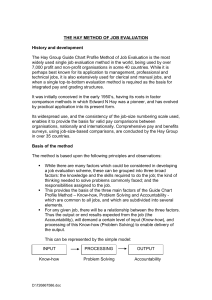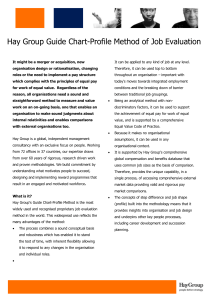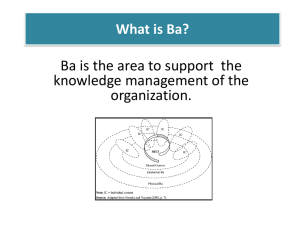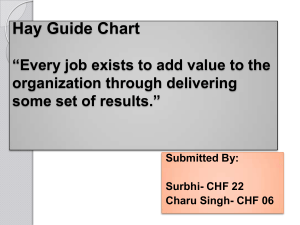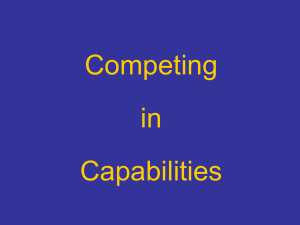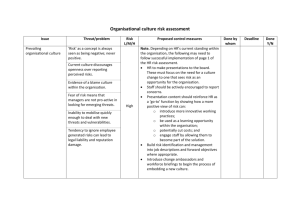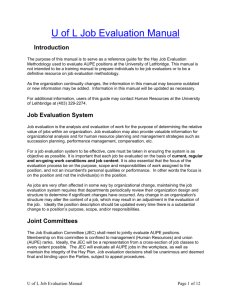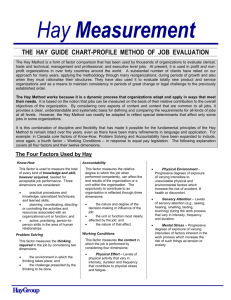The Hay Method of Job Evaluation
advertisement
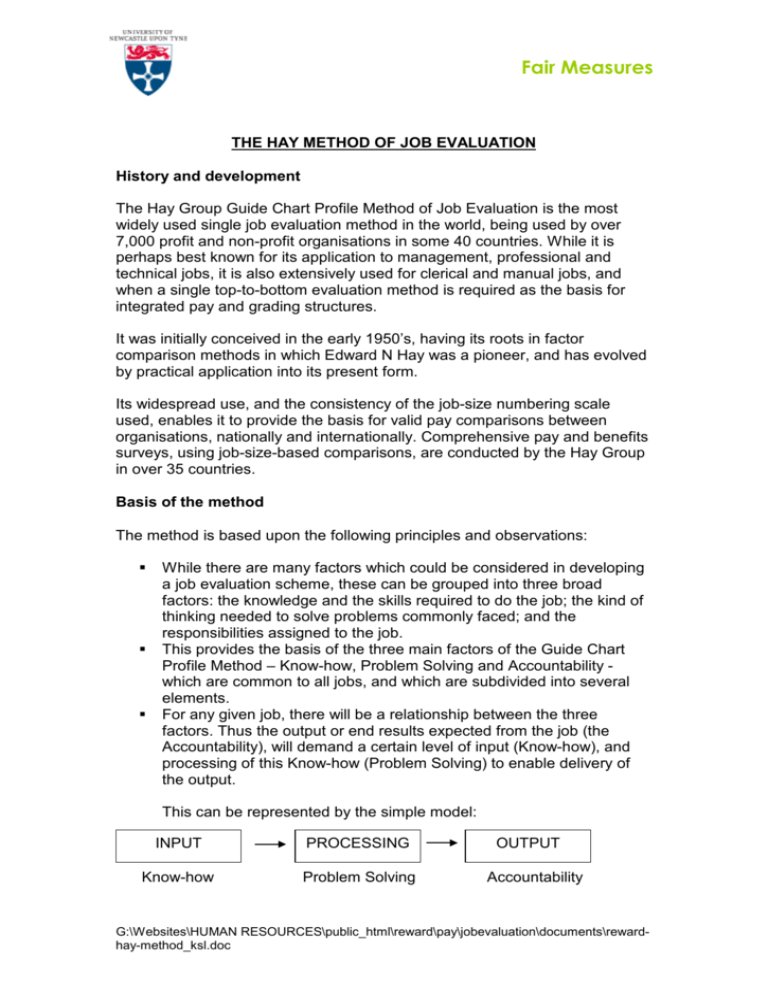
Fair Measures THE HAY METHOD OF JOB EVALUATION History and development The Hay Group Guide Chart Profile Method of Job Evaluation is the most widely used single job evaluation method in the world, being used by over 7,000 profit and non-profit organisations in some 40 countries. While it is perhaps best known for its application to management, professional and technical jobs, it is also extensively used for clerical and manual jobs, and when a single top-to-bottom evaluation method is required as the basis for integrated pay and grading structures. It was initially conceived in the early 1950’s, having its roots in factor comparison methods in which Edward N Hay was a pioneer, and has evolved by practical application into its present form. Its widespread use, and the consistency of the job-size numbering scale used, enables it to provide the basis for valid pay comparisons between organisations, nationally and internationally. Comprehensive pay and benefits surveys, using job-size-based comparisons, are conducted by the Hay Group in over 35 countries. Basis of the method The method is based upon the following principles and observations: § § § While there are many factors which could be considered in developing a job evaluation scheme, these can be grouped into three broad factors: the knowledge and the skills required to do the job; the kind of thinking needed to solve problems commonly faced; and the responsibilities assigned to the job. This provides the basis of the three main factors of the Guide Chart Profile Method – Know-how, Problem Solving and Accountability which are common to all jobs, and which are subdivided into several elements. For any given job, there will be a relationship between the three factors. Thus the output or end results expected from the job (the Accountability), will demand a certain level of input (Know-how), and processing of this Know-how (Problem Solving) to enable delivery of the output. This can be represented by the simple model: INPUT PROCESSING Know-how Problem Solving OUTPUT Accountability G:\Websites\HUMAN RESOURCES\public_html\reward\pay\jobevaluation\documents\rewardhay-method_ksl.doc Fair Measures § § § § Thus jobs can be characterised not only by the size or level of each factor, but also by the balance between the factors – the Profile - which reflect the ‘shape’ of the job. Thus, for example, a research job is likely to be heavily loaded towards Know-how and Problem Solving, whereas for a sales representative or production manager, the balance will be shifted towards Accountability. In addition to evaluating each factor, evaluators also assess the profile of the job, which provides an important check on consistency of treatment. The ability of evaluators to discern a difference between two jobs depends not only on the absolute difference, but on how big this difference is in relation to the size of the jobs themselves. Thus the numbering patterns used in the Guide Charts are based upon a geometric scale, each number being a constant percentage greater than the previous one. This percentage has been empirically determined at 15 per cent, as best representing the ability of experienced evaluators to discern a difference in any factor between two jobs. This ‘step difference’ concept provides the basic building block for the scales and for the comparisons between jobs, with one step representing a ‘just discernible difference’. Jobs should not be evaluated in isolation, but viewed in their organisational context, so that working relationships both vertically and horizontally throughout the organisation are taken into account. In order that the focus is on jobs, not the performance of job holders, ‘standard acceptable performance’ is assumed. Similarly, jobs are evaluated independently of any market-driven pay conditions which may pertain, recognising that these require addressing explicitly as pay issues, not job-size considerations. Components of the method The method has three main factors and eight dimensions as follows: Know-how The sum of every kind of knowledge, skill and experience, however acquired, needed for acceptable job performance. Its three dimensions are requirements for: 1. Practical procedures, specialised techniques and knowledge within occupational fields, commercial functions, and professional or scientific disciplines. 2. Integrating and harmonising the diverse elements involved in managerial situations. This involves, in some combination, skills in planning, organising, executing, controlling and evaluating and may be exercised consultatively as well as executively. 3. Active, practicing person-to-person skills in work with other people, within or outside the organisation. G:\Websites\HUMAN RESOURCES\public_html\reward\pay\jobevaluation\documents\rewardhay-method_ksl.doc Fair Measures Problem Solving The original, self-starting use of Know-how required by the job to identify, define, and resolve problems. ‘You think with what you know’. This is true of even the most creative work. The raw material of any thinking is knowledge of facts, principles and means. For that reason, Problem Solving is treated as a percentage of Know-how. Problem Solving has two dimensions: 1. the environment in which thinking takes place; 2. the challenge presented by the thinking to be done. Accountability The answerability for action and for the consequences of that action. It is the measured effect of the job on end results of the organisation. It has three dimensions in the following order of importance: 1. Freedom to act: the extent of the personal, procedural, or systematic guidance or control of actions in relation to the primary emphasis of the job. 2. Job impact on end results: the extent to which the job can directly affect actions necessary to produce results within its primary emphasis. 3. Magnitude: the portion of the total organisation encompassed by the primary emphasis of the job. Where possible, magnitude is expressed in annual financial figures representing the area of primary emphasis of the job. Beyond these three factors of job content, additional scales can be used to assess factors relating to the context in which the job operates; for example, unpleasant working environment, hazards, physical demands, sensory attention, etc. When such factors are important for the jobs under consideration, scales are generated to enable their assessment within the context of the organisation. Taken from Armstrong, Michael, and Murlis, Helen, Reward Management: A Handbook of Remuneration, Strategy and Practice: 5th Edition, 2004 G:\Websites\HUMAN RESOURCES\public_html\reward\pay\jobevaluation\documents\rewardhay-method_ksl.doc
